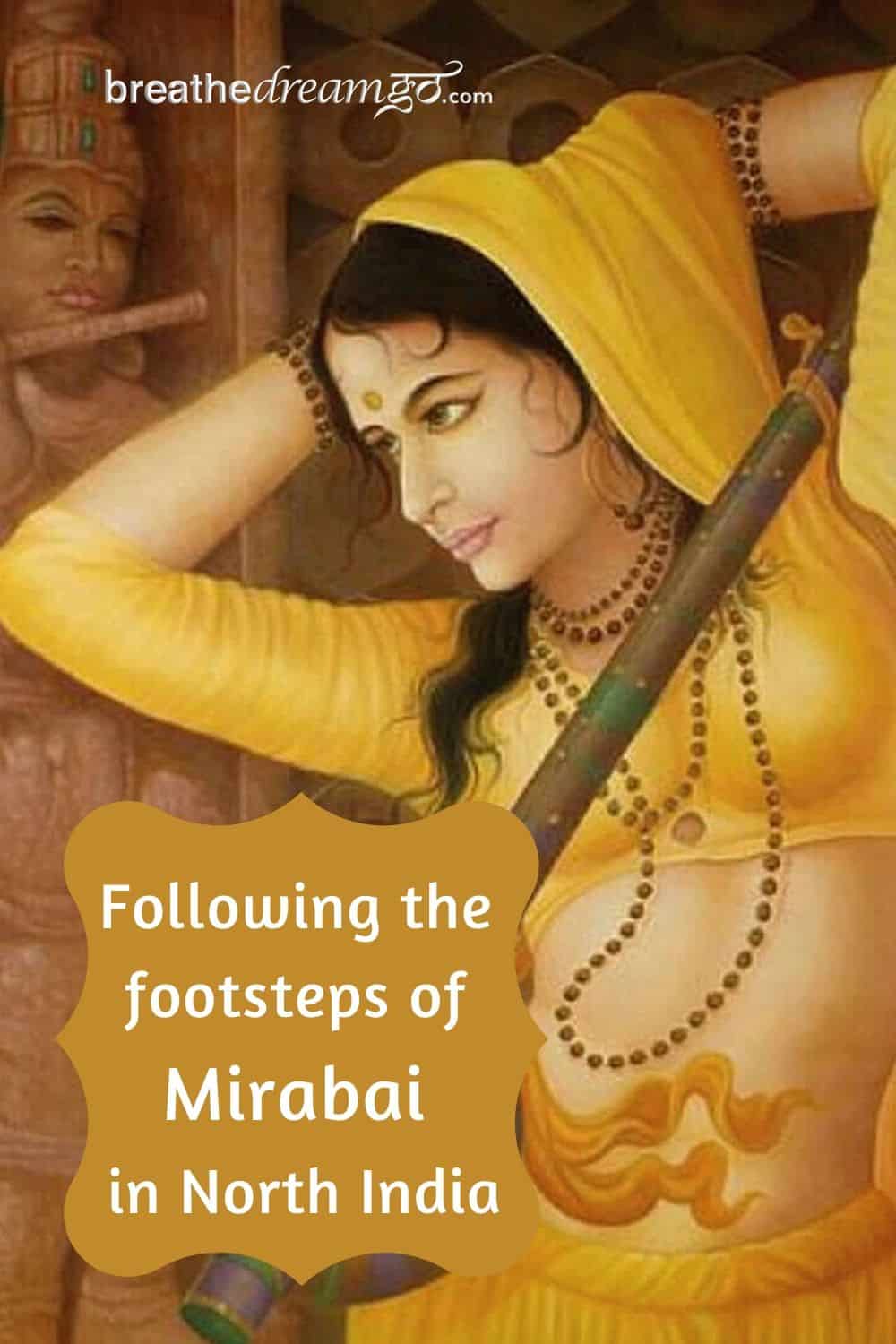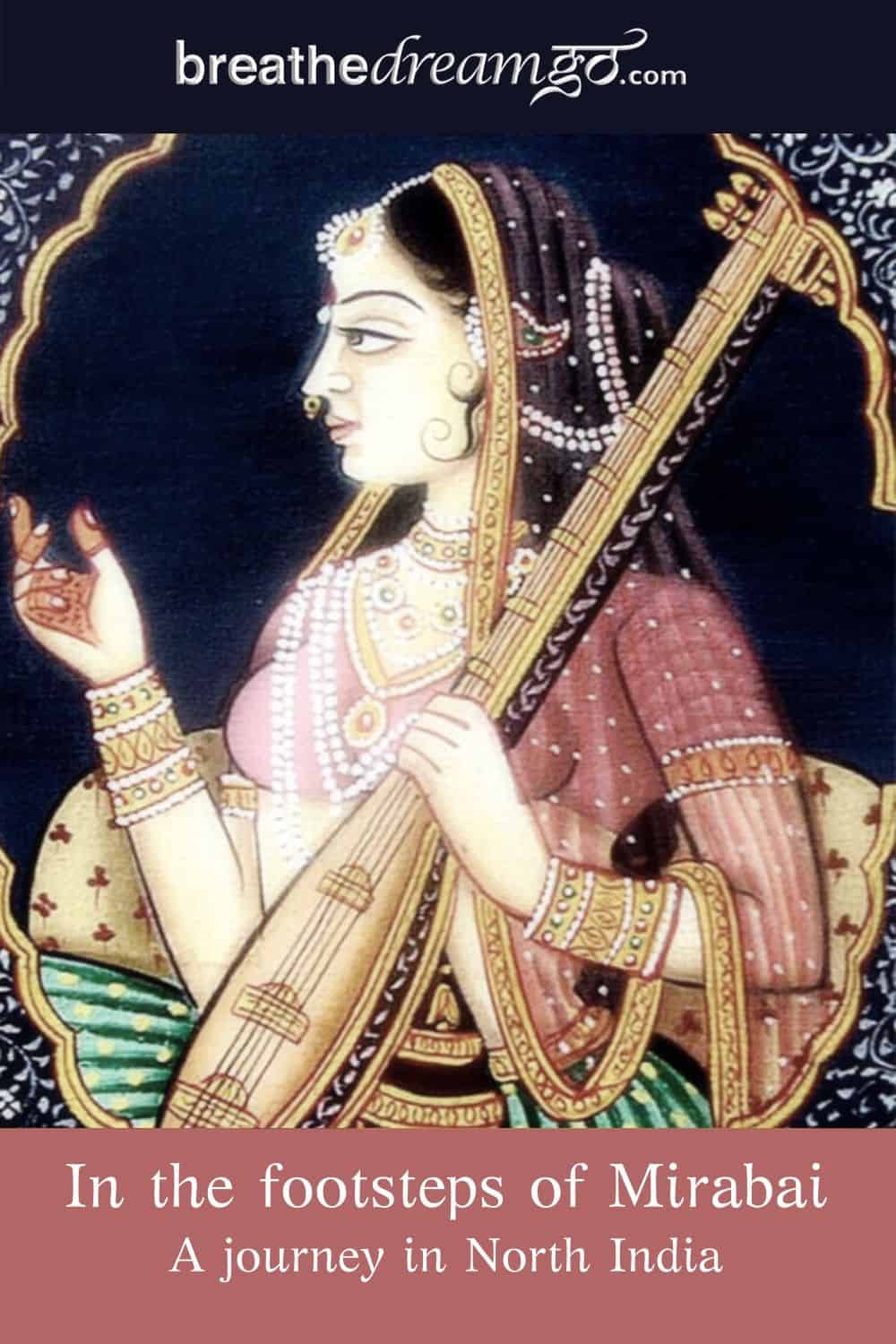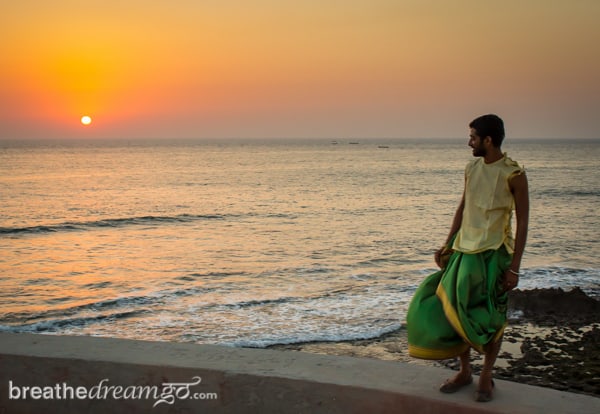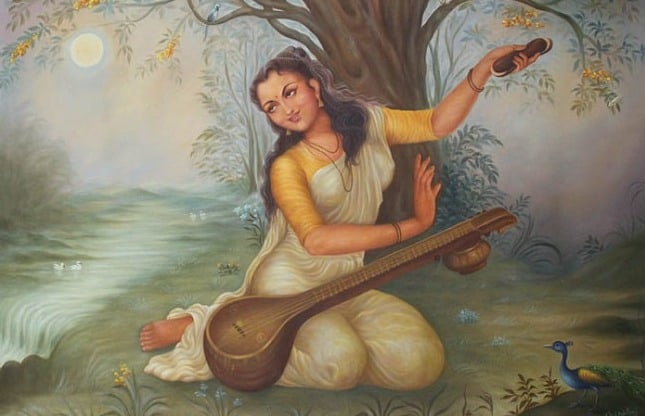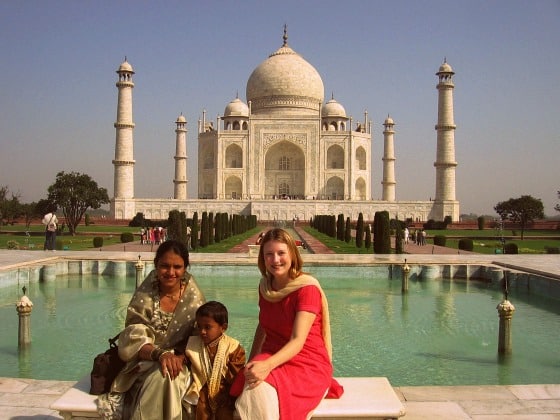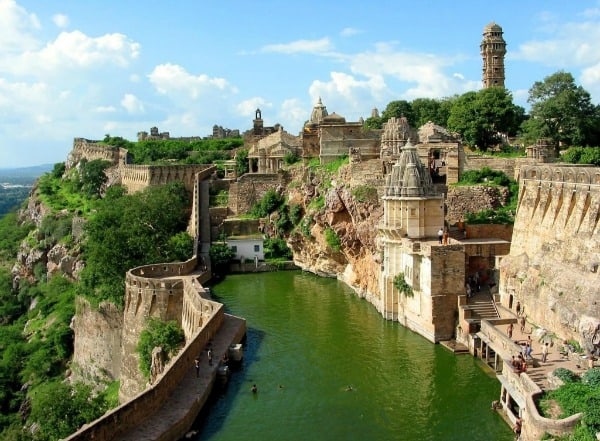
Table of Contents
Mirabai’s unbelievable story becomes real on the ramparts of mighty Chittorgarh Fort
RAJASTHAN IS THE ‘LAND OF KINGS,’ a desert state with a rich history of chivalrous rulers, silk-road trade routes and romantic tales. Fantastical palaces and sand-castle forts, loping camels and screeching peacocks, women in neon-bright saris and men in bulbous turbans. Rajasthan is all your fantasies of India writ large, and the setting for many of India’s epic stories, including the improbable tale of Mirabai.
Read the Mirabai Expedition series:
Part 1: Walking in the footsteps of Mirabai
Part 2: Uncovering the feminine in Merta, Rajasthan
Part 3: The footsteps of royalty in Chittorgarh, Rajasthan
Part 4: Releasing the bonds of love in Dwarka, Gujarat
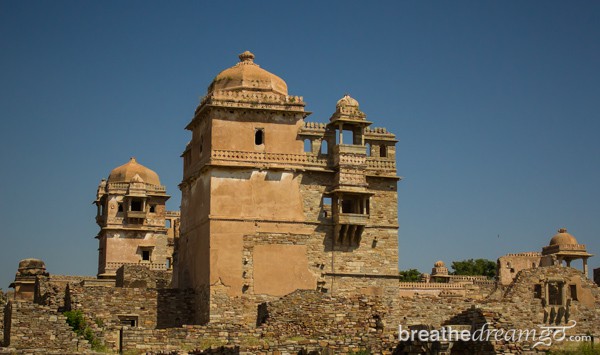
Mirabai was born a Rajput princess in Rajasthan in 1504. Her father, Ratan Singh, was the second son of Rao Duda ji, a descendent of Rao Jodha ji Rathor, the founder of Jodhpur. She was a renowned beauty, known for her sweet voice and devotional nature, and was sought in marriage by a powerful Rajput family. She married Bhojraj, the son of Rana Sangram Singh, the powerful King of Mewar, of the Sisodia Dynasty, and the ruler the kingdom of Chittorgarh.
The Rajputs were the proud rulers of Rajasthan, whose exploits are the stuff of legend. And few fables match those that hail from the towering ramparts of Chittorgarh.
When we read, we use our imaginations to engage with the characters, fill in the blanks of the story and picture the scenes unfolding on the page (or screen). But sometimes, we don’t get the full impact of the scene or situation until we somehow experience it ourselves. This is why we travel. Reading about travel is not enough for many of us, we must experience it.
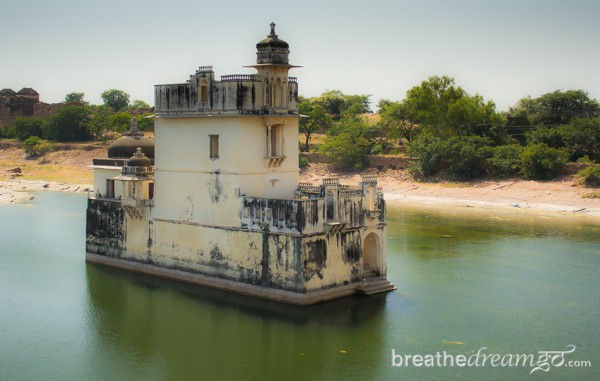
Mirabai’s royal connections
Likewise the Mirabai story. I read that she married Prince Bhojraj and moved to Chittorgarh to live with her husband’s family, as all Indian brides did, and most still do. But now I’m in Chittorgarh Fort, near Udaipur, and seeing the remains of the fort, the crumbling palaces, and well-maintained temples, her story is becoming real. It’s becoming real because I am walking where she walked and prayed; and it’s becoming real because I can see for myself the prestige and power of her husband’s family. This was no minor royal family she quarrelled with; these were not petty princes that she walked away from.
Chittorgarh is one of the biggest forts in India, an important historical and sacred site, and one of the major tourist attractions of Rajasthan. Spread out over 700 acres on a 180 metre-high mountain-top plateau, Chittorgarh is impressive by any measure. It was the capital of Mewar under the Rajputs from the 7th century to the 16th. To Indians, the imposing Victory Tower alone, which thrusts upwards from within the fort, is a symbol of patriotism. And tales such as the story of Queen Padmini, who commit Jauhar (self-sacrifice) along with the women of the court to protect their honour, is a point of pride.

Avtaar and I drive into a Chittorgarh on a hot, sunny day and I’m struck by the vast size of the fort, which covers the mountain plateau, and how it towers over the modern town below. We head straight for the hotel, about 25 kilometres outside of town. Castle Bijaipur is, by far, the top hotel in the vicinity and it’s well worth the drive.
Partially still occupied by the royal family, Castle Bijaipur is the most evocative heritage hotel I’ve ever stayed in. They managed to modernize the rooms without losing the original character, and they’ve wisely left the patina of age. I feel like a princess in my large room with private balcony that overlooks the town below, and the warren of medieval streets.
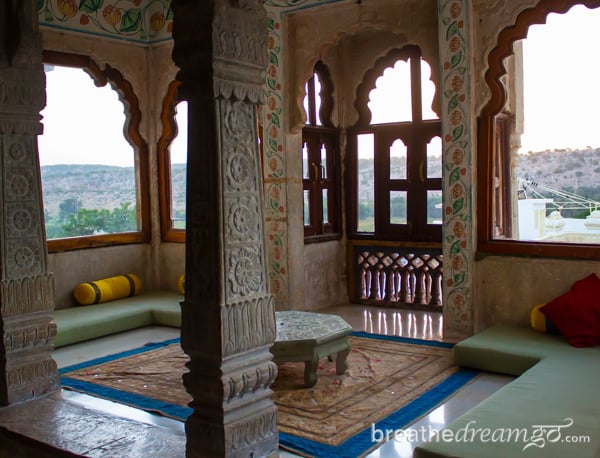
Fairytale castle in Rajasthan
At dusk I walk the grounds of the hotel, going right up onto the roof to take photos from among the turrets. I sit on a cushioned window seat overlooking the inner courtyard, and also try out a swing seat. Before sunrise, I get up and walk through the quiet empty grounds to the massive gate, to await my friend Ajay, who’s arriving by train from Delhi. I feel lost in time, as if I’ve stepped into the pages of a fairytale. In the morning, I’m awakened both by the devotional music coming from a nearby Hindu temple, and the call to prayer from an equally nearby mosque.
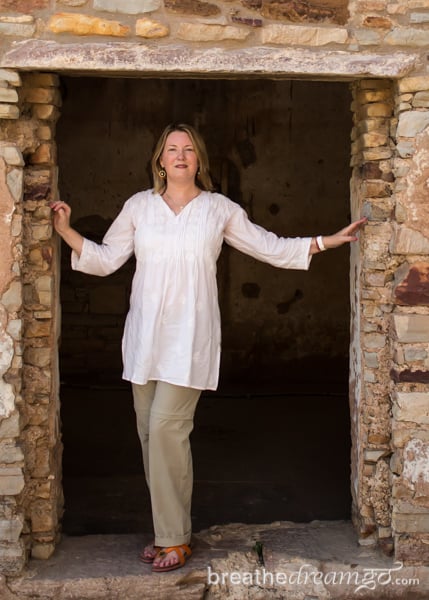
Castle Bijaipur has put me into exactly the right frame of mind to spend the day in Chittorgarh Fort. It’s a hot day, but we set out early and drive directly to the fort, engaging a guide at the entrance who travels with us. Far too big to walk — the circumference of the walls is 16 kilometres — we drive from place to place. And our first stop is the 15th century Kumbha Palace, a vast site of crumbling walls and clambering monkeys. While the guide wants to give us every word of his memorized spiel, I entreat him to just show me the Mirabai Palace. To my surprise he takes me directly there, to a small, building in the very corner, with a sweeping vista. Though in ruins, the effect is still very much as if we’re in a palace in the clouds.
I’m absolutely charmed.
I take my time, imagining Mirabai here as a princess, enjoying the privacy and breeziness of her lofty corner. It has an unmistakably feminine atmosphere, perhaps because of the small scale and large windows. The interiors of the two buildings are in ruins, so I can’t get a sense of the rooms, but they couldn’t have been large.
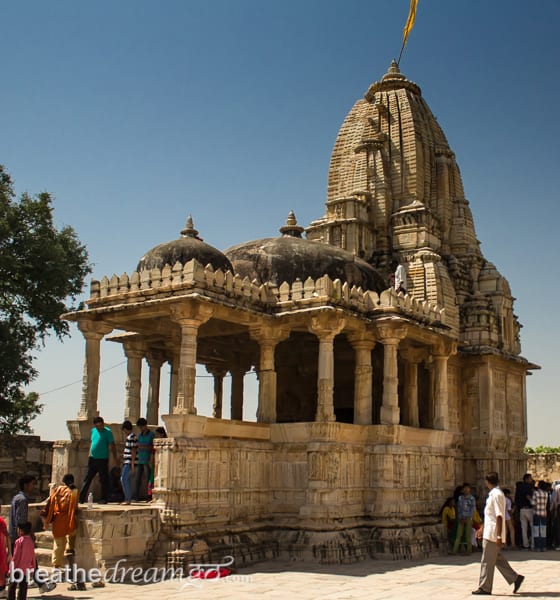
Our next stop is the Mirabai Temple, built for her by her father-in-law, the King of Mewar, who was initially pleased with her religious devotion. It is of course a Krishna temple, a small and intricately carved building on the grounds of a much-larger Vishnu Temple. The temple is extremely well-maintained, and a sacred pilgrimage destination. A woman sits in the entrance singing Mirabai’s songs, and inside, a beautiful white statue of Mirabai is placed in front of the Krishna murti.
It’s a delightful temple and I’m thrilled to be here, however, I am very surprised to see a stall set up inside selling books and souvenirs.
A signboard inside the temple reads: “Meera Temple. This is the temple where Meera worshipped Lord Girdhar Gopal — chanted hymns and danced. Here is the place where poison was turned to nectar.”
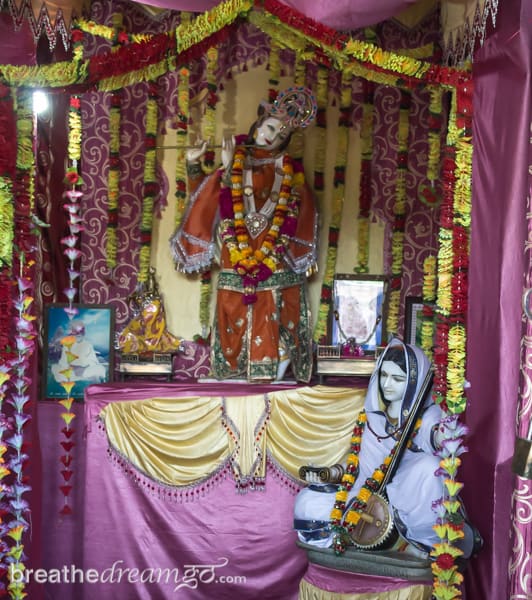
Mirabai escapes three attempts on her life
Mirabai’s in-laws did not accept her ecstatic devotion, and felt her behaviour was not seemly for a Rajput princess. After her husband died, and word got out that Muslim Emperor Akbar — the sworn enemy of the proud and independent Hindu Rajputs of Chittorgarh — had visited her in disguise, they attempted to kill her. Three times they tried, and three times she was miraculously saved.
The first time, she was given a basket of flowers with a poisonous snake hidden inside. The second time, she was given a cup of poison to drink. The third time she was asked to drown herself. The Lord Krishna was credited with the divine interventions that saved her, by turning the snake to a stone, the poison to nectar, and by lifting her out of the water. According to this sign, the third attempt on her life happened at this temple. It was after these incidents that Mirabai left her royal home forever, to wander as a sadhu in north India.
After spending the day touring the fabled fort, I leave for the most romantic city in India, and perhaps the world.
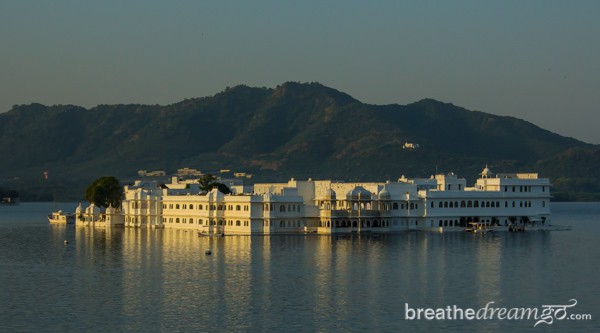
India’s most romantic city
Udaipur is only a few hours’ drive west of Chittorgarh, but it is in a different century. While the immense fort is stuck in time, a relic of past glories, Udaipur has kept pace with the intervening centuries. Medieval palaces have been fitted with modern plumbing and electricity, and the rich and famous come to play.
I’m in Udaipur to try and get a feeling for a living version of Rajasthani royalty. I’m at Jagat Niwas Hotel, in a room facing Lake Pichola and the famed Taj Lake Palace Hotel, drinking in the romance that gilds every surface of this enchanted place. I wake at dawn and take photos of the sunrise over the lake. I tour the City Palace and walked the narrow market lanes. I eat on the roof of the hotel and watch the sun set.
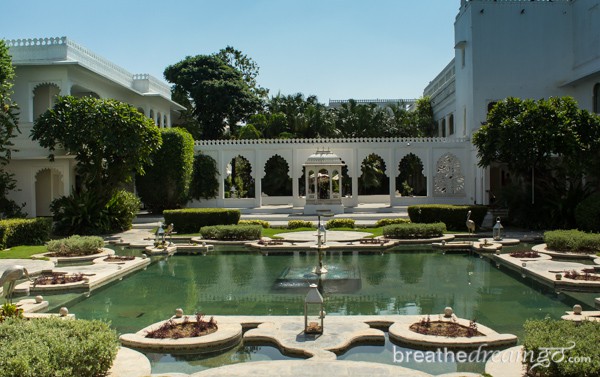
India’s most romantic hotel
I walk to the Taj Lake Palace Hotel boat launch, near the City Palace and the home of the Maharajah of Udaipur, and boat over to the hotel for lunch and a tour. Visitors are not allowed, you have to be a guest, so I feel very lucky to get this privileged view of one of the world’s most famous and most photographed hotels.
The Taj Lake Palace Hotel, originally called the Jag Niwas, was built in the 1740s by Maharana Jagat Singh II of Udaipur as a summer pleasure palace. Eventually, it was abandoned and left to decay, until Bhagwat Singh decided to convert it into a luxury hotel in the 1960s.
In 1971 the Taj Group took over management of the hotel, and made it into a pleasure palace for the new royalty — wealthy business tycoons, celebrities, jet setters. Sumptuous dining rooms, a fantastical garden, a luxurious pool, a floating spa (aboard a boat), an elegant bar and opulent suites. Everything you would expect.
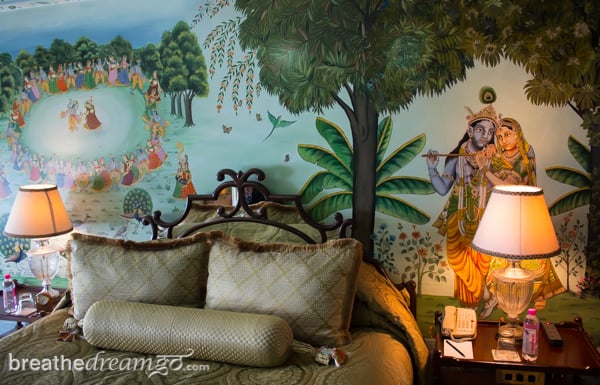
I eat lavishly in an alcove surrounded on three sides by water, and when I step back into the launch to return to the mainland, I feel like Cinderella leaving the ball.
It’s hard to leave these luxurious surroundings, I admit. And makes me realize how hard it must have been to be Mirabai, and leave the comfort and safety of her royal home for life on the road, following the song of her soul.
Perhaps like Mirabai, I don’t know, my return to reality takes a very downward spiral when I am dropped off at the Udaipur train station, to take a train, to Ahmedabad, that no longer exists.
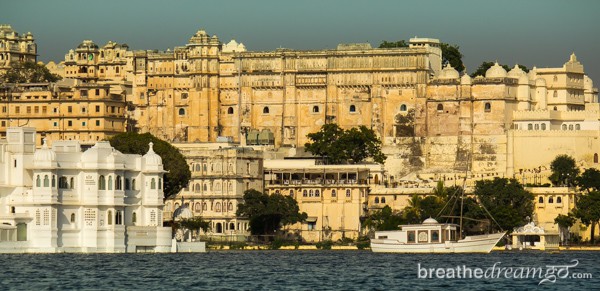
If you enjoyed this post, you can….
Sign up to The Travel Newsletter in the sidebar and follow Breathedreamgo on all social media platforms including Instagram, TripAdvisor, Facebook, Pinterest, and Twitter. Thank you!


